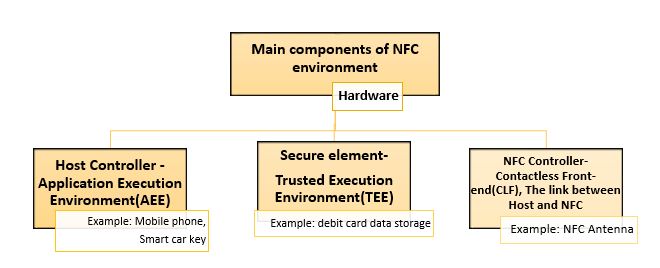Near Field Communication
by Vismita Sonagra, Clemson Automotive Engineering Graduate Student
- Basic Description
-
Near Field Communication (NFC), as a subset of Radio Frequency Identification (RFID) Technology, is a bidirectional, short range, low power communications technology. Its range is 5 to 10 cm, with transmission data rates of 106 kbps, 212 kbps and 424 kbps. The frequency of the RF field is 13.56 MHz. NFC has become very popular recently and is now embedded in almost every Smart Phone. This technology is being increasingly used in the automotive environment for enhanced security and infotainment purposes.
NFC works on the principle of electromagnetic field induction. One device, the initiator, uses magnetic induction to create a radio wave field that the target or receiver can detect and access, allowing small amounts of data to be transferred wirelessly over a relatively short distance. The basic difference between RFID and NFC is that, while RFID is a one-way signal protocol, NFC allows two-way communication and exchange of information. The following chart shows the hardware components of NFC.

- Operating Modes
-
Peer to Peer Mode: Enables communication between two NFC devices. The device which starts the communication is called Initiator, the other is called Target. Peer-to-Peer mode is standardized on the ISO/IEC 18092 standard.
Reader/Writer Mode: Allows NFC devices to communicate with NFC Forum Tags. These tags are typically passive components, like the one on a poster or a car window sticker. This mode is also known as Passive Mode.
Card Emulation Mode: Allows the NFC device to communicate with standard RFID readers, enabling contact-less payments and ticketing by NFC devices without changing the existing infrastructure.
- NFC Applications in the Automotive Industry
-
Communication: Bluetooth pairing by holding the NFC enabled device in front of the car’s NFC device for a couple of seconds, WiFi configuration..
Interaction between customer and the car: Personalization options for the user like infotainment, HVAC settings, side mirrors, seats, navigation data, etc. stored on a NFC tag (e.g. a key fob), are possible applications.
Information: Car user manuals and other information can be retrieved using NFC tags.
Car key with NFC interface: The NFC interface can be used to identify the driver for the purposes of accessing and starting the car.
-

NFC Enabled Car Security System
Hyundai recently unveiled the 2015 i30 Hatchback model with NFC enabled car keys in Europe, with an NFC tag located on the window to allow the driver access from outside, It also provides access to infotainment features by placing an NFC-enabled smart phone on the center console. More information about this system can be found here.
NFC is an important development in automotive connectivity. Several car companies are collaborating with mobile phone companies to establish NFC standards for interoperability.
- Sensors
- Radio Frequency Identification (RFID) Sensor
- Actuators
- RF Transmitter
- Data Communications
- Radio Frequency (RF) Signals at 13.56 MHz
- Manufacturers
- Giesecke and Devrient, Gemalto, Harman, Infineon, NXP, Melexis, ST Microelectronics, Texas Instruments
- For More Information
- [1] Near Field Communication, Wikipedia.
- [2] About NFC, nfc-forum.org.
- [3] Everything You Need To Know About Near Field Communication, Dan Nosowitz, popsci.com, Jan. 3, 2011.
- [4] World’s Top Auto Makers to Work on Putting NFC in Cars, Christopher Brown, NFC World, Mar. 18, 2011.
- [5] Near Field Communication, Martin Kerschberger, July 7, 2011.
- [6] Hyundai Connectivity Concept Turns a Smartphone into a Key, Stephen Edelstein, Digital Trends, Dec. 28, 2012.
- [7] Smart Keys for Cyber-Cars: Secure Smartphone-based NFC-enabled Car Immobilizer, C. Busold et al., CODASPY’13, Feb. 2013.
- [8] Simpleshow Explains Near Field Communication (NFC), YouTube, Feb. 19, 2013.
- [9] Near Field Communication - What a Smartphone Can do With a Car, YouTube, Feb. 20, 2013.
- [10] Continental Tests NFC Car Keys, Rian Boden, NFC World, Apr. 10, 2013.
- [11] Near-Field Communications and Connected Cars, Lars Reger, Embedded.com, Aug. 21, 2013.
|

